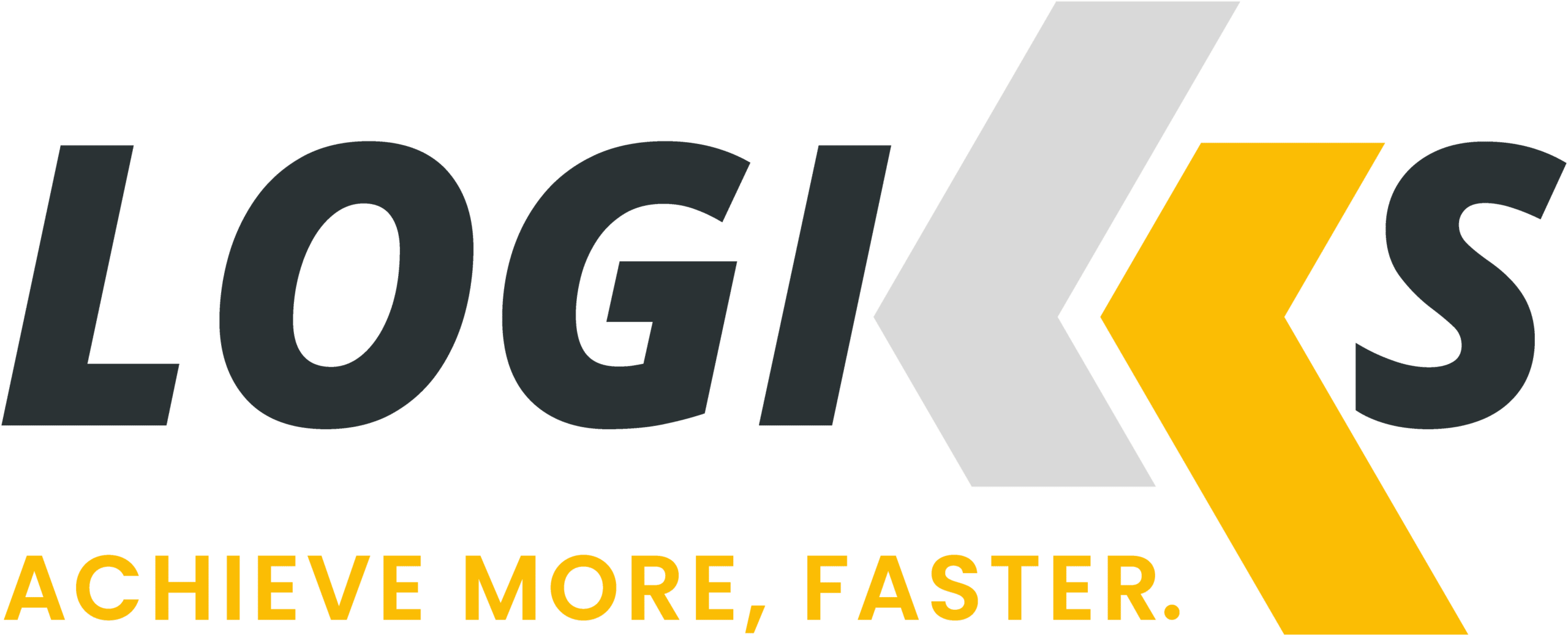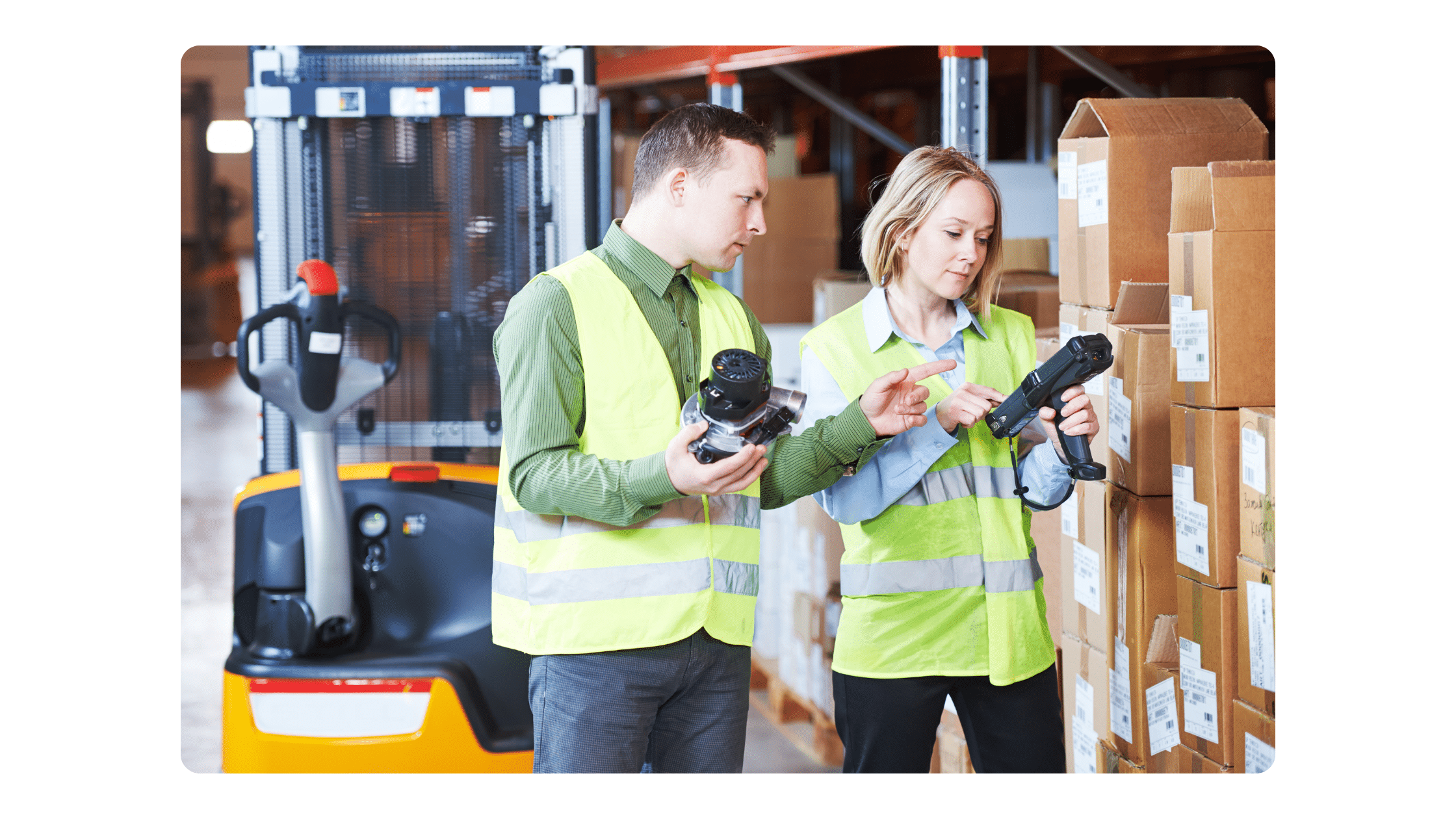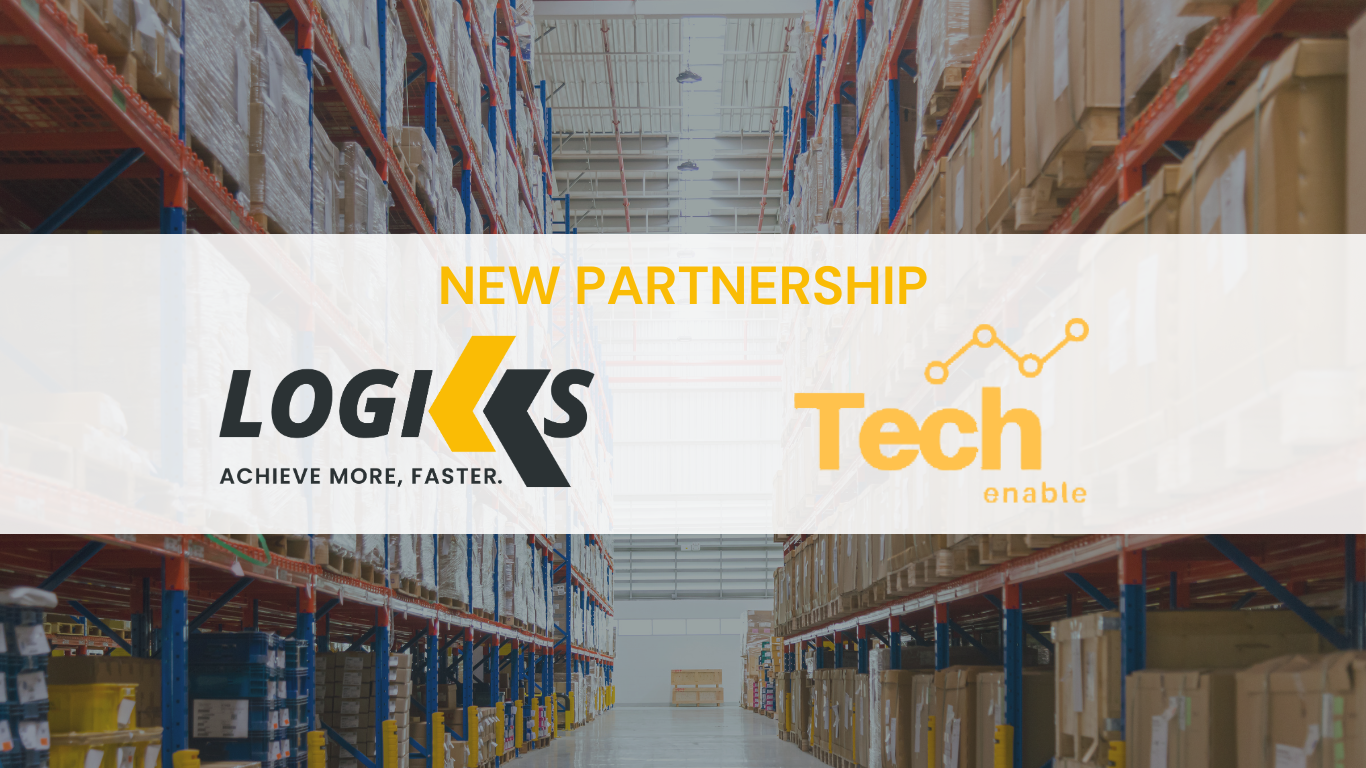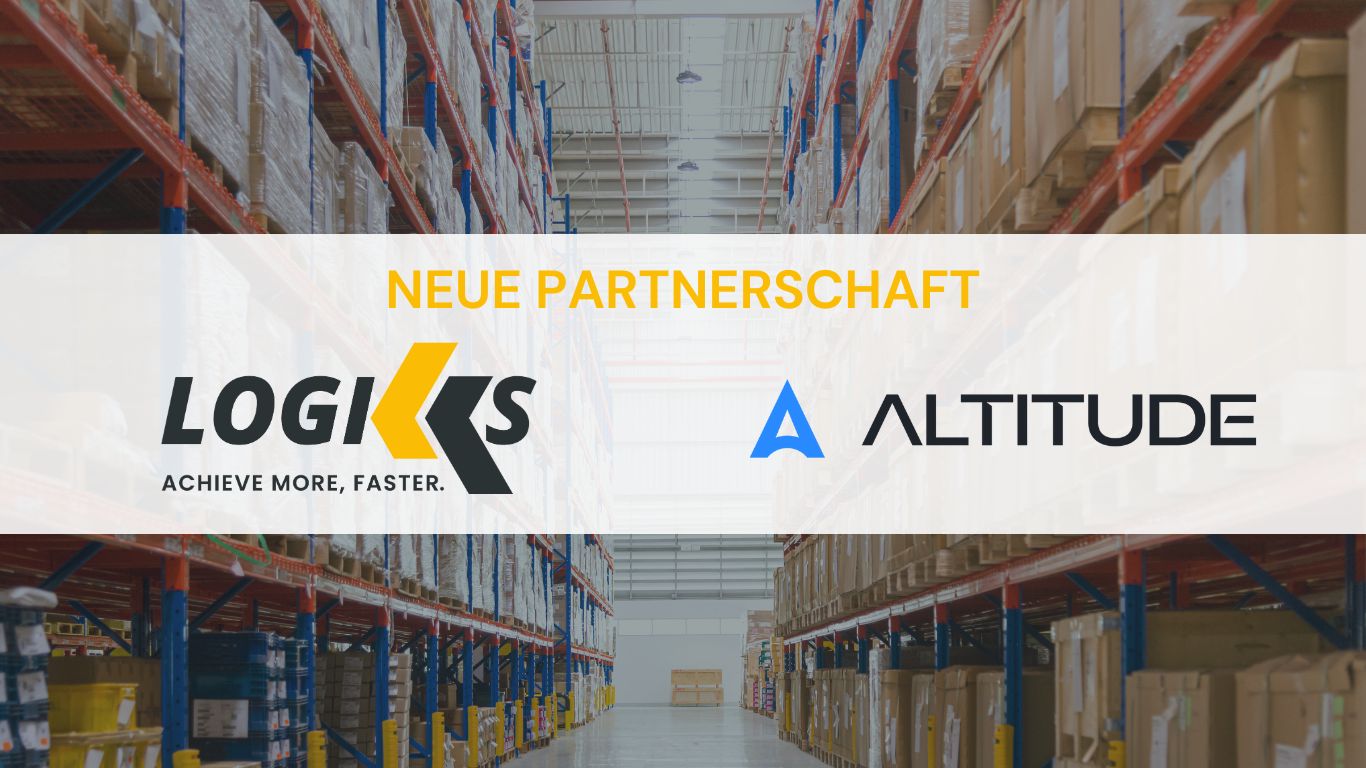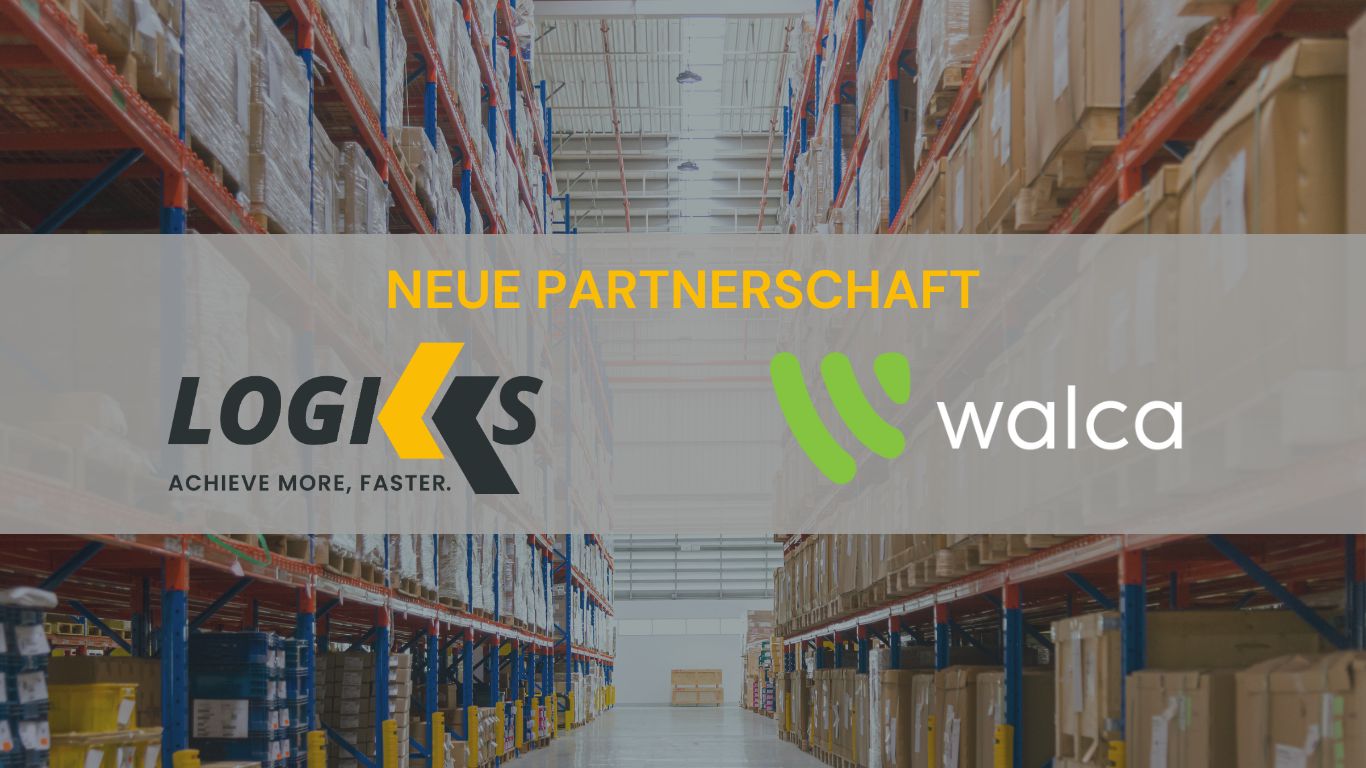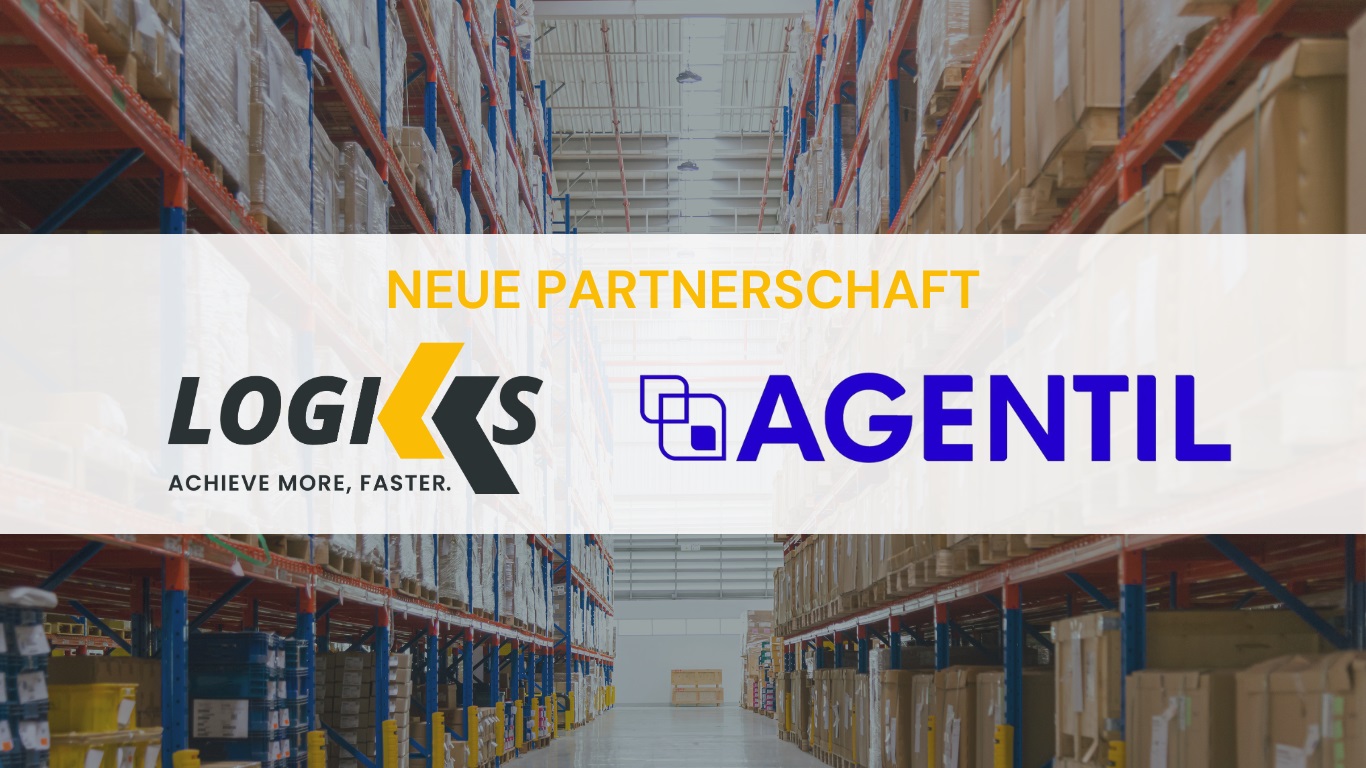Barcode, QR Code, RFID – Which one fits your needs?
Advantages and disadvantages of each Media Type and the right use cases
In the fast-paced world of retail, logistics, and inventory management, efficient and accurate tracking of products is paramount. This is where Warehouse Management Suite comes into play, supporting all three media types, offering a versatile solution for businesses aiming to improve their warehouse operations. This article examines how barcode, QR Code, and RFID technologies work, and explores the many different applications of this cutting-edge device.
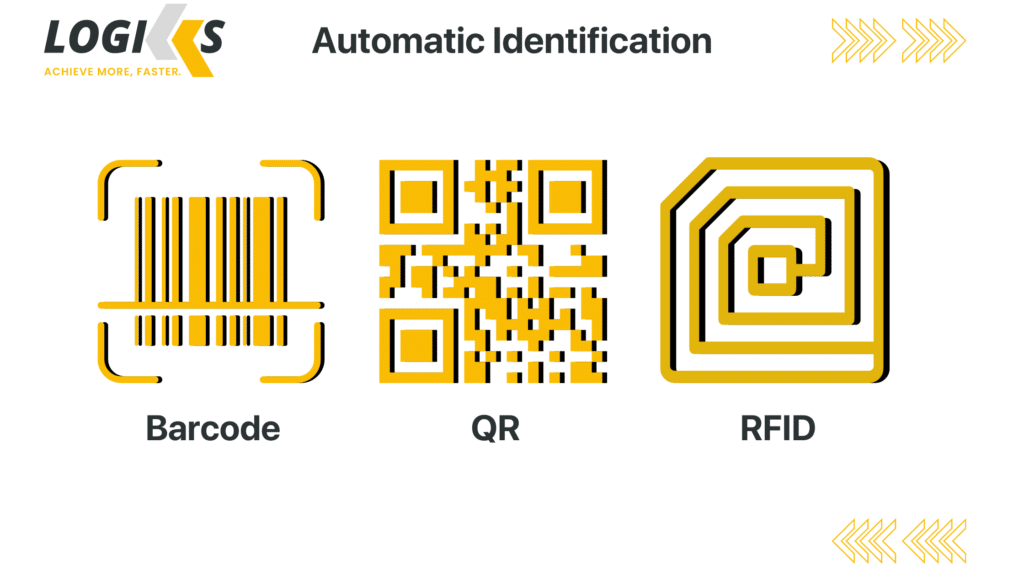
Understanding Barcode Media
Barcode media is the backbone of product identification and inventory management systems worldwide. It comes in various forms, each with its own set of advantages and applications. Here, we’ll focus on three primary types: barcode, QR Code, and RFID.
Barcode: The 1-Dimensional Pioneer
Barcodes are the most common and widely used type of product identification in the market. This series of parallel lines that may differ in their widths and spaces allows them to alter the spacings and widths of these lines to store data. This 1-dimensional format is read using a laser or LED light in the Logiks Barcode Scanner, and therefore this digital data could be understood by computers.
Barcodes are especially useful for the purchasing process, because of their simplicity and cheap availability. They are well tuned in to standard retail stores where the products are scanned over a short distance.
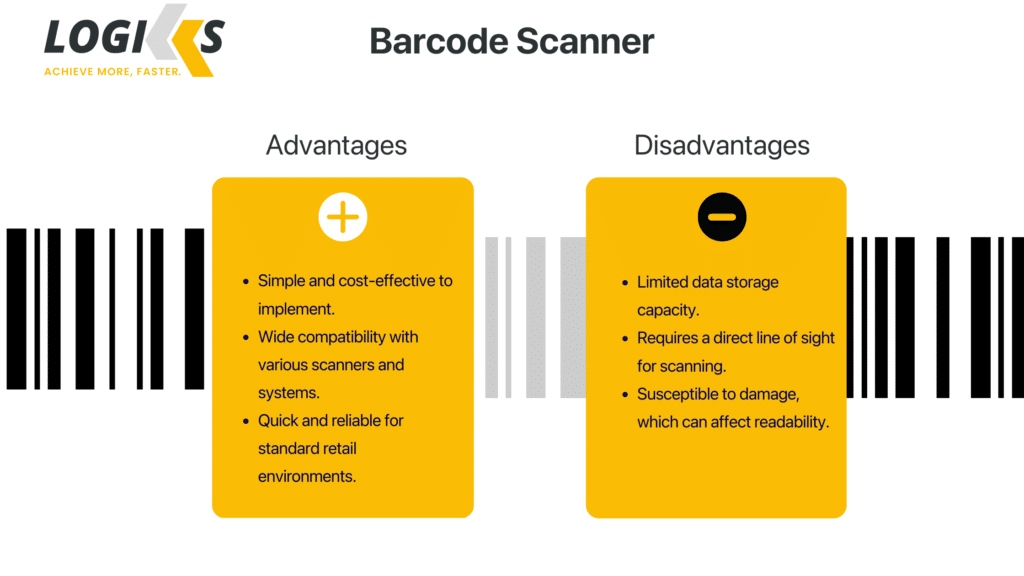
Advantages of Barcode Scanners
- Simple and cost-effective to implement.
- Wide compatibility with various scanners and systems.
- Quick and reliable for standard retail environments.
- Barcode scanner works on wider distance compared to QR Scanner
Disadvantages of Barcode Scanners
- Limited data storage capacity.
- Requires a direct line of sight for scanning.
- Susceptible to damage, which can affect readability.
Examples of Real-Life Application of Barcode Scanners:
Retail Checkout
In a retail environment, cashiers use barcode scanners to quickly and accurately scan items at the checkout counter. This process speeds up transactions, reduces the likelihood of human error, and ensures accurate pricing and inventory tracking. Customers benefit from a faster checkout experience, and the store maintains an up-to-date inventory.
Receiving Shipments
In a warehouse, staff often encounter the task of receiving shipments and updating inventory. For this process, traditional barcodes are highly preferable due to their simplicity and cost-effectiveness. As shipments arrive, staff can quickly scan the barcodes on each package to confirm receipt and update the inventory system. This is particularly efficient in environments where the volume of items is manageable, and the focus is on speed and accuracy. Barcodes are also widely used in shipping labels, making them a universally compatible choice
QR code: The 2-D Evolution
QR codes are the next level of barcodes which can store not only a smooth line but also more information than that. They are scanned and interpreted by the camera on the Logiks Barcode Scanner which captures the code in a single shot. QR Codes can hold a variety of types of data such as URLs, contact details and even Wi-Fi passwords.
The QR Codes have increased capacity and flexibility and hence overcome the obstacles of a certain distance. The scanner should be placed a short distance from the QR Code, ranging between 2-3 inches to a foot, depending on the code’s size and the camera’s performance. With this characteristic, QR Codes are clearly intended for applications where more information needs to be accessed quickly for a given but limited range.
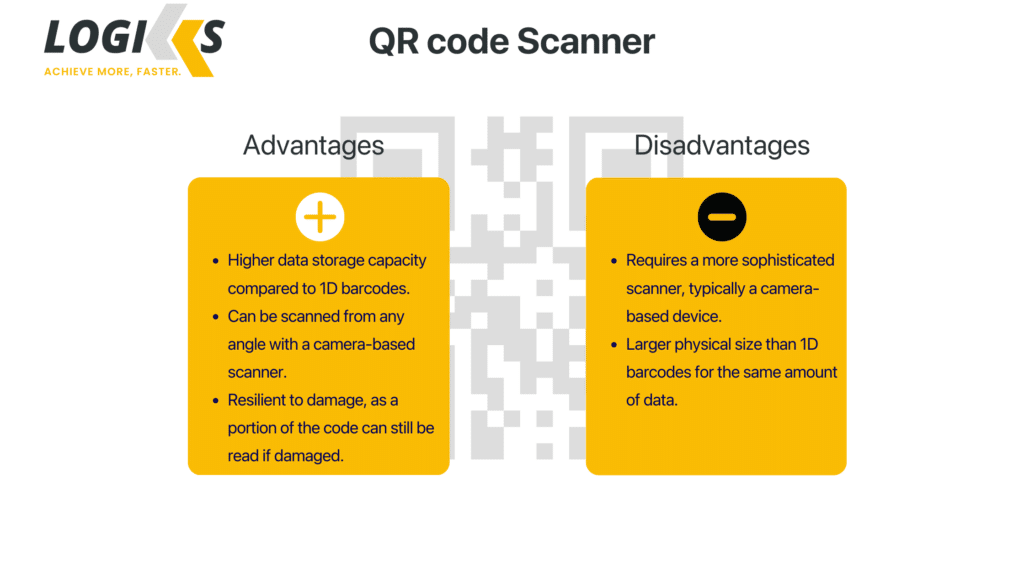
Advantages of QR Scanners
- Higher data storage capacity compared to 1D barcodes.
- Can be scanned from any angle with a camera-based scanner.
- Resilient to damage, as a portion of the code can still be read if damaged.
Disadvantages of QR Scanners
- Requires a more sophisticated scanner, typically a camera-based device.
- Larger physical size than 1D barcodes for the same amount of data.
- The most limited scanning range (2-2.5 cm)
Examples of Real-Life Application of QR code Scanners:
Inventory Management
Warehouse staff use QR codes to manage inventory levels. By scanning QR codes on product packaging, they can easily update stock levels in real-time, track the movement of goods, and quickly locate items in a large warehouse. This system enhances efficiency, reduces the risk of stockouts, and improves overall inventory accuracy.
Product Information Access
For accessing detailed product information, QR codes are the preferred choice. Warehouse staff can scan QR codes on items or shelves to quickly retrieve extensive data, such as product specifications, handling instructions, or expiration dates. This is particularly beneficial in warehouses that handle complex products or require strict compliance with regulations. The ability to store more information than traditional barcodes and the ease of scanning with a smartphone or tablet make QR codes ideal for this use case.
RFID: The 3-Dimensional Revolution
In the three options, RFID (Radio Frequency Identification) is the most sophisticated one and is well-known for being able to scan the 3-dimension. Unlike barcodes and QR Codes, which can be read only when they are within line of sight, RFID tags can be read from a distance and even through layers of materials like plastics, wood and human bodies. This functionality is provided by a small chip and antenna implanted in the RFID tag, which interacts with the Logiks Warehouse Suite through radio-frequency communication.
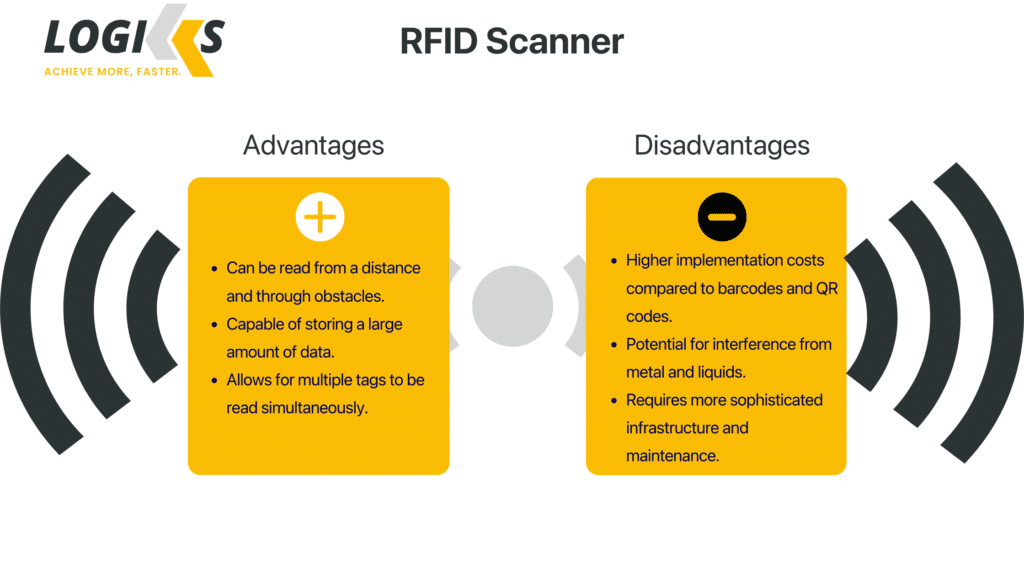
Advantages of RFID Scanners
- Can be read from a distance and through obstacles.
- Capable of storing a large amount of data.
- Allows for multiple tags to be read simultaneously.
Disadvantages of RFID Scanners
- Higher implementation costs compared to barcodes and QR codes.
- Potential for interference from metal and liquids.
- Requires more sophisticated infrastructure and maintenance.
Examples of Real-Life Application of RFID Scanners:
Asset Tracking
In a corporate office, RFID tags are attached to valuable assets such as laptops, projectors, and other equipment. Staff can use RFID readers to quickly take inventory of these assets, check their status, and locate them if they are misplaced. This system streamlines asset management, reduces the risk of loss, and ensures that equipment is properly maintained.
Bulk Inventory Checks (RFID)
When conducting bulk inventory checks, RFID technology is the clear winner. In a large warehouse, staff can use RFID readers to scan multiple items simultaneously without the need for a direct line of sight. This dramatically speeds up the process of inventory audits, as entire pallets or shelves can be scanned in seconds. RFID is especially useful in warehouses with high shelves or densely packed items, where traditional barcodes or QR codes would require individual and direct scanning.
Integration of Barcode, QR Code, and RFID Technologies
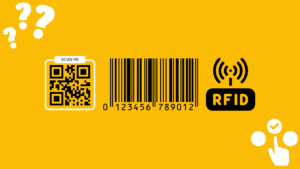
The matrix below lays out the main feature aspects of QR Codes, RFID, and Barcode Scanners, summarizing their advantages and disadvantages. Technology selection for each application depends on factors like infrastructure, environment, and business needs.
For example, QR Code is suited for applications having high-capacity data storage without the need for another party like mobile payments or marketing campaigns. Storage of the information and scanning it from another angle increases versatility of this technology and makes it usable in many fields. Nevertheless, their low read range restricts their usefulness in areas where items are hard to come by.
RFID implementation offers a long-read range and obstacles reading capability which is a clear advantage in asset tracking and inventory management in big warehouses and retailing spaces. The possibility of scanning multiple items enhances efficiency and accuracy in these situations. RFID, despite its high cost and integration complexity, is an invaluable tool where the 24×7 real-time tracking and security of data is a very sensitive issue.
Therefore, when cost-effectiveness and simplicity are the main considerations, conventional Barcode Scanners work well for businesses like small shops or libraries. Besides, their small data storage capacity as well as call for a straight line of sight to work properly means they are unreliable when it comes to complicated inventory and instead better at short-range scanning.
So is the choice of QR codes, RFID or barcode systems depending on what the specific needs of the application are (data capacity, read range, and environmental conditions). Every technology, having its distinctive benefits, is best adapted for a specific purpose, from a conventional retail checkout to an advanced stock management system.
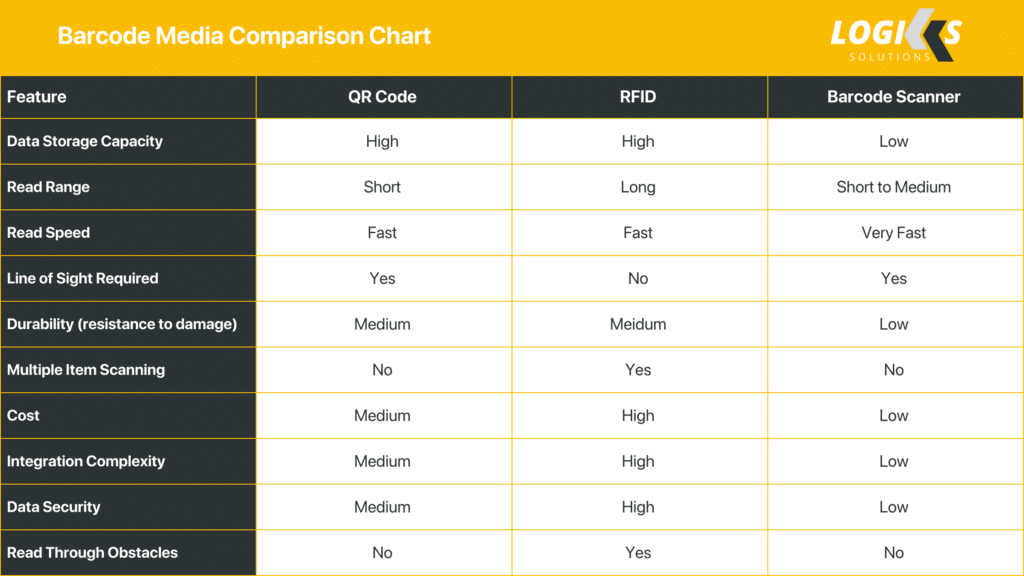
How to Pick the Right Kind of Barcode Media for Your Business Needs?
Firstly, you should evaluate and list your exact specifications of what type of data needs to be scanned before purchasing the most suitable media type.
These needs might include:
- Volume of products to be scanned
- Scan environment
- Types of barcodes
The warehouse that requires high-volume scanning is better off with a multi-directional reader with a high read rate, such as RFD90 Sleds, which has a solid read rate of 1,300 tags/sec. These will enable you to perform control counts much faster and increase the speed of workflow accuracy.
The working environment is also important in a large warehouse; a long-range scanner with a capability of 75 feet. For example, RFD9090 sled would be more appropriate for these operations, rather than one with standard range.
Additionally, it is also necessary that the ease of use and compatibility of the barcode scanner are duly considered with existing systems. Having a scanner that fits into the ecosystem and works with multiple mobile devices quickly like RFD90 Sled and Zebra eConnex™ adaptor provides reliable connectivity is useful for an efficient workflow.
On the other hand, the scanner is enabled with the Bluetooth® 5.3 wireless capability which makes it easy for it to connect to different platforms such as Android™, iOS, or Windows.
You should analyze these parameters, and by knowing the precise needs of your warehouse operations you can choose a barcode scanner that besides meeting the current requirements also provides the adaptive capacity to facilitate future changes and demands. Below you will find the markets for the application of scanning technology and which type of media is preferred for specific tasks.
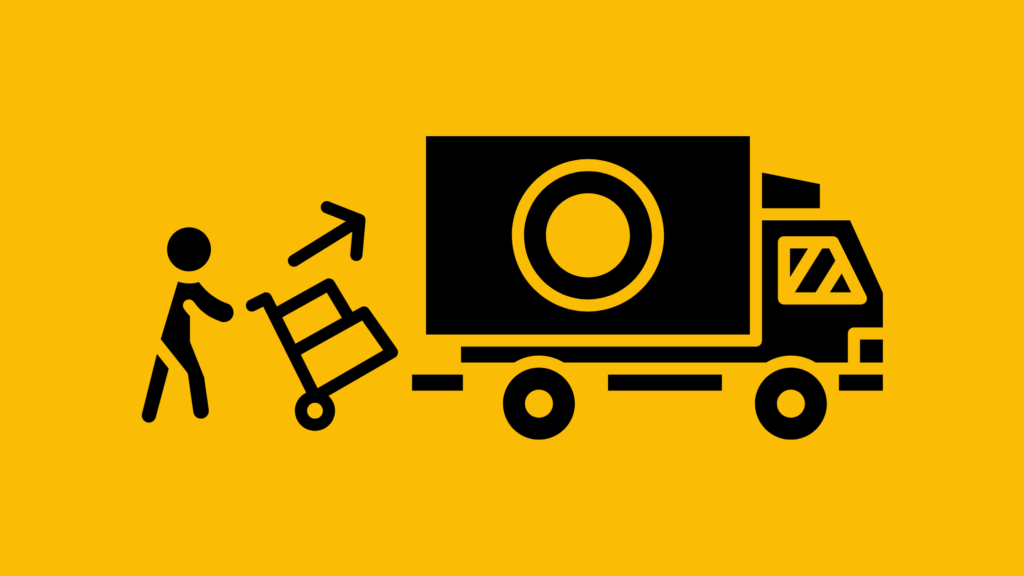
Transportation & Logistics
- Baggage Tracking
- Cycle Counting
- Item Locating
- Cold Chain
- Cross-Docking Operations
- Proof of Delivery and Pickup
- Container and Pallet Tracking
- Driver Identification and Authentication
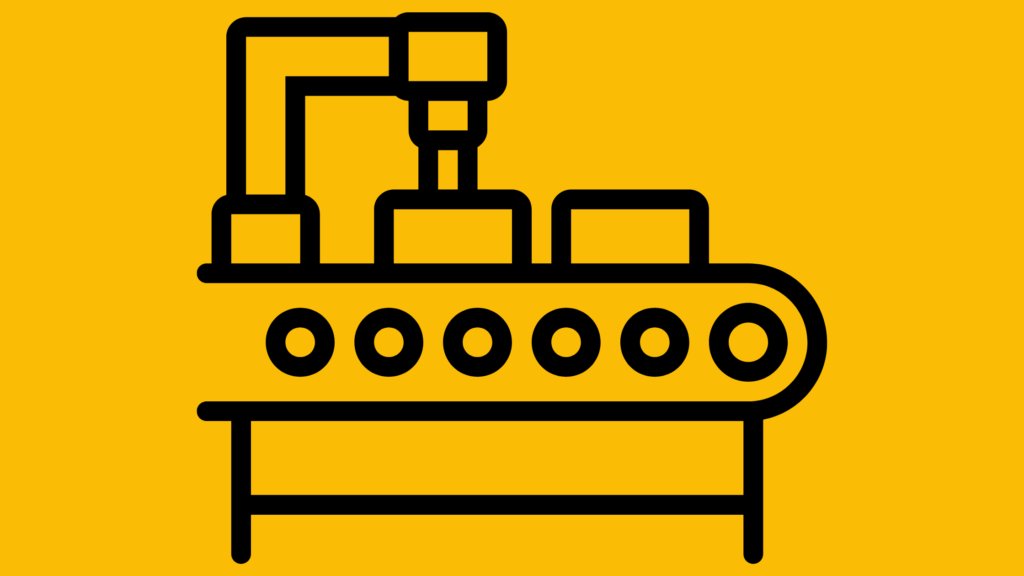
Manufacturing
- Work in Progress (WIP) Tracking
- Raw Materials Inventory
- Pipeline/Utility Tracking
- Item Locating
- RTO Tracking
- Quality Control Inspections
- Tool and Equipment Tracking
- Maintenance and Repair Operations (MRO)
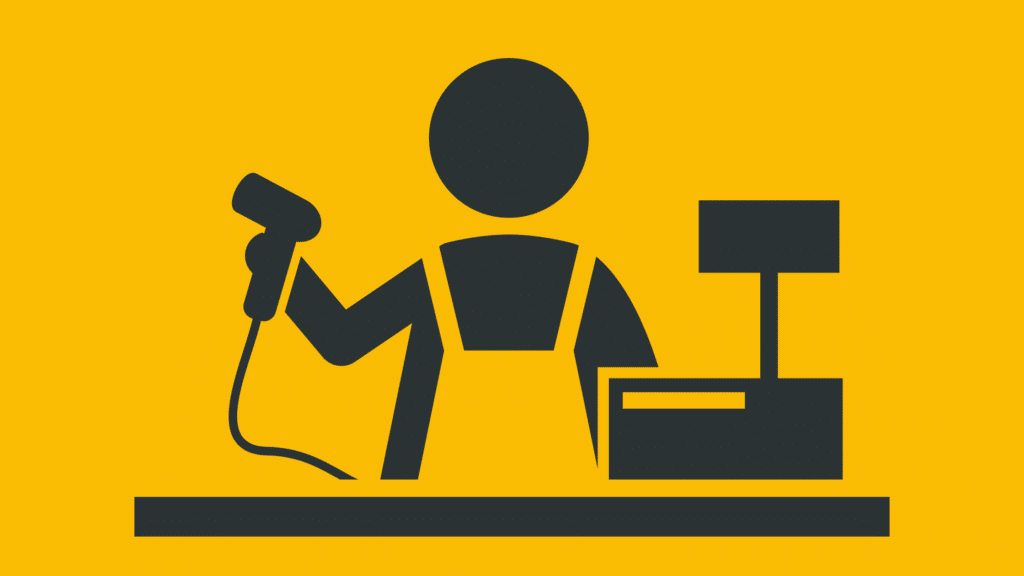
E-Commerce & Retail
- Price Verification
- Inventory Management
- Point of Sale (POS)
- Transactions
- Loyalty Program Management
- Product Information Access
- Online Order Fulfillment
- Returns Processing
- Shelf Replenishment
- Asset Tracking
Other Popular Applications of Different Media Types

Preferred Media: Barcode
Use Case: Airports use barcodes on luggage tags to efficiently track and sort baggage through various checkpoints until it reaches the destination.
Preferred Media: RFID
Use Case: Warehouses use RFID tags on inventory items to quickly perform cycle counts, ensuring accurate stock levels without disrupting operations.
Preferred Media: RFID
Use Case: Retail stores use RFID to locate specific items on the sales floor or in the backroom, reducing search time and improving customer service.
Preferred Media: RFID
Use Case: RFID tags with temperature sensors are used to monitor and track the temperature of perishable goods during transportation and storage.
Preferred Media: RFID
Use Case: Logistics companies use RFID tags to track and manage returnable transport objects like pallets and containers throughout the supply chain.
Preferred Media: Depends on the environment (Barcode or RFID)
Use Case: Manufacturing facilities use barcodes or RFID to track the progress of products through various stages of production.
Preferred Media: Depends on the volume and environment (Barcode or RFID)
Use Case: Factories use barcodes or RFID tags to manage and track raw material inventory levels in real-time.
Preferred Media: RFID
Use Case: Utility companies use RFID tags to track and monitor the maintenance and inspection of pipelines and other infrastructure.
